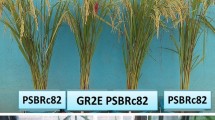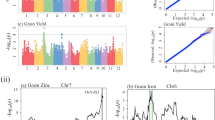Abstract
Rice (Oryza sativa L.) is a staple food for more than half of the world's population. To meet the ever-increasing demand for food, because of population growth and improved living standards, world rice production needs to double by 20301. The development of new elite rice varieties with high yield and superior quality is challenging for traditional breeding approaches, and new strategies need to be developed. Here, we report the successful development of new elite varieties by pyramiding major genes that significantly contribute to grain quality and yield from three parents over five years. The new varieties exhibit higher yield potential and better grain quality than their parental varieties and the China's leading super-hybrid rice, Liang-you-pai-jiu (LYP9 or Pei-ai 64S/93-11). Our results demonstrate that rational design is a powerful strategy for meeting the challenges of future crop breeding, particularly in pyramiding multiple complex traits.
This is a preview of subscription content, access via your institution
Access options
Access Nature and 54 other Nature Portfolio journals
Get Nature+, our best-value online-access subscription
$29.99 / 30 days
cancel any time
Subscribe to this journal
Receive 12 digital issues and online access to articles
$119.00 per year
only $9.92 per issue
Buy this article
- Purchase on Springer Link
- Instant access to full article PDF
Prices may be subject to local taxes which are calculated during checkout



Similar content being viewed by others
References
Foley, J. A. et al. Solutions for a cultivated planet. Nature 478, 337–342 (2011).
Cheng, S. H. et al. Super hybrid rice breeding in China: achievements and prospects. J. Integ. Plant Biol. 49, 805–810 (2007).
Tilman, D., Balzer, C., Hill, J. & Befort, B. L. Global food demand and the sustainable intensification of agriculture. Proc. Natl Acad. Sci. USA 108, 20260–20264 (2011).
Xie, H. A. in Rice Genetics, Breeding, and Varieties Genealogy in China Vol. 1 (ed. Wan, J. M. ) Ch. 742, 85 (China Agricultural Press, 2010).
Suwannaporn, P. & Linnemann, A. Rice-eating quality among consumers in different rice grain preference countries. J. Sens. Stud. 23, 1–13 (2008).
Liao, F. M., Zhou, K. L., Yang, H. H. & Xu, Q. S. Comparison of grain quality between F1 hybrids and their parents in indica hybrid rice. Chinese J. Rice Sci. 17, 134–140 (2003).
Liu, Q. et al. Stable inheritance of the antisense waxy gene in transgenic rice with reduced amylose level and improved quality. Transgenic Res. 12, 71–82 (2003).
Zhang, Q. Strategies for developing Green super rice. Proc. Natl Acad. Sci. USA 104, 16402–16409 (2007).
Min, J. et al. Analysis on grain quality of indica hybrid rice combinations bred during recent twenty-five years in China. Chin. J. Rice Sci. 25, 201–205 (2011).
Xu, Y. & Crouch, J. H. Marker-assisted selection in plant breeding: from publications to practice. Crop Sci. 48, 391–407 (2008).
Septiningsih, E. M. et al. Development of submergence-tolerant rice cultivars: the Sub1 locus and beyond. Ann. Bot. 103, 151–160 (2009).
Singh, S. et al. Pyramiding three bacterial blight resistance genes (xa5, xa13 and Xa21) using marker-assisted selection into indica rice cultivar PR106. Theor. Appl. Genet. 102, 1011–1015 (2001).
Suh, J. P. et al. Development of resistant gene-pyramided japonica rice for multiple biotic stresses using molecular marker-assisted selection. Plant Breed. 3, 333–345 (2015).
Tan, M. K. et al. A SNP marker for the selection of HfrDrd, a Hessian fly-response gene in wheat. Mol. Breeding. 35, 230 (2015).
Li, Z. K. & Zhang, F. Rice breeding in the post-genomics era: from concept to practice. Curr. Opin. Plant Biol. 16, 261–269 (2013).
Peleman, J. D. & van der Voort, J. R. Breeding by design. Trends Plant Sci. 8, 330–334 (2003).
Wang, Y., Xue, Y. & Li, J. Towards molecular breeding and improvement of rice in China. Trends Plant Sci. 10, 610–614 (2005).
Jiang, Y. et al. Rice functional genomics research: progress and implications for crop genetic improvement. Biotechnol. Adv. 30, 1059–1070 (2012).
Ikeda, M., Miura, K., Aya, K., Kitano, H. & Matsuoka, M. Genes offering the potential for designing yield-related traits in rice. Curr. Opin. Plant Biol. 16, 213–220 (2013).
Qian, Q. et al. Breeding high-yield superior-quality hybrid super-rice by rational design. Natl Sci. Rev. 3 (2016).
Xing, Y. & Zhang, Q. Genetic and molecular bases of rice yield. Annu. Rev. Plant Biol. 61, 421–442 (2010).
Tian, Z. et al. Allelic diversities in rice starch biosynthesis lead to a diverse array of rice eating and cooking qualities. Proc. Natl Acad. Sci. USA 106, 21760–21765 (2009).
Wu, M. L. & Xiong, Z. M. in Rice Varieties and their Genealogy in China (eds Lin, S. C. & Min, S. K. ) 33 (Shanghai Science and Technology Press, 1991).
Liao, F. Peiliangyou Teqing, a new high-yielding, two-line hybrid rice. Int. Rice Res. News 19, 13–14 (1994).
Liu, Q., Cai, X. & Li, Q. Molecular marker-assisted selection for improving cooking and eating quality in Teqing and its hybrid rice. Acta Agronom. Sin. 32, 64–69 (2006).
Yang, P. et al. Proteomic analysis of the response of Liangyoupeijiu (super high-yield hybrid rice) seedlings to cold stress. J. Integ. Plant Biol. 48, 945–951 (2006).
Ohdan, T. et al. Expression profiling of genes involved in starch synthesis in sink and source organs of rice. J. Exp. Bot. 56, 3229–3244 (2005).
Fan, C. et al. GS3, a major QTL for grain length and weight and minor QTL for grain width and thickness in rice, encodes a putative transmembrane protein. Theor. Appl. Genet. 112, 1164–1171 (2006).
Shomura, A. et al. Deletion in a gene associated with grain size increased yields during rice domestication. Nat. Genet. 40, 1023–1028 (2008).
Ashikari, M. et al. Cytokinin oxidase regulates rice grain production. Science 309, 741–745 (2005).
Ookawa, T. et al. New approach for rice improvement using a pleiotropic QTL gene for lodging resistance and yield. Nat. Commun. 1, 132 (2010).
Spielmeyer, W., Ellis, M. H. & Chandler, P. M. Semidwarf (sd-1), “Green revolution” rice, contains a defective gibberellin 20-oxidase gene. Proc. Natl Acad. Sci. USA 99, 9043–9048 (2002).
Yu, B. et al. Tac1, a major quantitative trait locus controlling tiller angle in rice. Plant J. 52, 891–898 (2007).
Yano, M. et al. Hd1, a major photoperiod sensitivity quantitative trait locus in rice, is closely related to the Arabidopsis flowering time gene CONSTANS. Plant Cell 12, 2473–2484 (2000).
Endo-Higashi, N. & Izawa, T. Flowering time genes Heading Date 1 and Early Heading Date 1 together control panicle development in rice. Plant Cell Physiol. 52, 1083–1094 (2011).
Xue, W. et al. Natural variation in Ghd7 is an important regulator of heading date and yield potential in rice. Nat. Genet. 40, 761–767 (2008).
Yan, W. H. et al. A major QTL, Ghd8, plays pleiotropic roles in regulating grain productivity, plant height, and heading date in rice. Mol. Plant 4, 319–330 (2011).
Wan, X. et al. QTL detection for eating quality of cooked rice in a population of chromosome segment substitution lines. Theor. Appl. Genet. 110, 71–79 (2004).
Lestari, P. et al. PCR marker-based evaluation of the eating quality of Japonica rice (Oryza sativa L.). J. Agric. Food Chem. 57, 2754–2762 (2009).
Gao, Z. Y. et al. Dissecting yield-associated loci in super hybrid rice by resequencing recombinant inbred lines and improving parental genome sequences. Proc. Natl Acad. Sci USA 110, 14492–14497 (2013).
Si, H. M. et al. Current situation and suggestions for development of two-line hybrid rice in China. Chin. J. Rice Sci. 25, 544–552 (2011).
Wang, D. et al. Optimizing hill seeding density for high-yielding hybrid rice in a single rice cropping system in South China. PLoS ONE 9, e109417 (2014).
Tang, R. et al. GB/T17891-1999 in National Standard of People's Republic of China (Standards Press of China, 1999).
Lai, S. et al. Cooking and eating quality of indica rice varieties from South China by using rice taste analyzer. Chin. J. Rice Sci. 25, 435–438 (2011).
Acknowledgements
This work was supported by the National Natural Science Foundation of China (grant nos. 91535205, 91435105 and 31521064), the National Key Basic Research Program (grant no. 2013CBA014) and the ‘Strategic Priority Research Program’ of the Chinese Academy of Sciences (grant no. XDA08000000).
Author information
Authors and Affiliations
Contributions
Q.Q., J.L. and Y.W. designed the project; D.Z. and Y.R. performed the experiments in this study; D.Z., G.D., Y.Y., L.H. and Y.L. performed the molecular assistant selection; D.Z., C.S. and G.Z. contributed to measuring the grain ECQ; J.X., J.H., L.Z. and Z.G. evaluated the taste and palatability of the cooked rice; Z.T. and G.X. were responsible for the development of the gene markers; Z.T., L.G. and X.H. performed the statistical analysis; and D.Z., Z.T., Q.Q. and J.L. wrote the manuscript.
Corresponding authors
Ethics declarations
Competing interests
The authors declare no competing financial interests.
Supplementary information
Supplementary Information
Supplementary Figures 1-7 and Supplementary Tables 1-7. (PDF 774 kb)
Rights and permissions
About this article
Cite this article
Zeng, D., Tian, Z., Rao, Y. et al. Rational design of high-yield and superior-quality rice. Nature Plants 3, 17031 (2017). https://doi.org/10.1038/nplants.2017.31
Received:
Accepted:
Published:
DOI: https://doi.org/10.1038/nplants.2017.31
This article is cited by
-
Pyramiding of Low Chalkiness QTLs Is an Effective Way to Reduce Rice Chalkiness
Rice (2024)
-
The Function of SD1 on Shoot Length and its Pyramiding Effect on Shoot Length and Plant Height in Rice (Oryza sativa L.)
Rice (2024)
-
Magnaporthe oryzae effector AvrPik-D targets a transcription factor WG7 to suppress rice immunity
Rice (2024)
-
A Synthetic Microbiome Based on Dominant Microbes in Wild Rice Rhizosphere to Promote Sulfur Utilization
Rice (2024)
-
Evolutionary and synteny analysis of HIS1, BADH2, GBSS1, and GBSS2 in rice: insights for effective introgression breeding strategies
Scientific Reports (2024)



